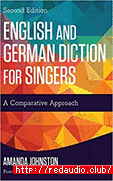Lyric diction is a portal to powerful and meaningful vocal performance because diction enables singers to communicate the vision of both the poet and the composer. The study of diction involves learning to perceive speech patterns in different languages, practicing their precise articulation, recognizing this in speech and singing, and developing an awareness of the refined movements of the articulators and their effects on singing tone.
In the second edition of English and German Diction for Singers, Amanda Johnston continues her comparative, modernized approach to lyric diction. This comprehensive resource offers a thorough analysis of the German and English languages and includes extensive oral drills, word lists, tables, charts, musical examples, and even tongue twisters. Unique to this publication is the illustration of the rhythmic timing and release of consonants within the International Phonetic Alphabet transcriptions in all musical examples.
This book is designed for both undergraduate and graduate courses in German and English lyric diction and is an invaluable resource for classical singers, vocal coaches, and voice teachers alike.
Improvements to the second edition include:
An online workbook that includes extensive written exercises suitable for classroom or independent use Chapter-by-chapter video clips that demonstrate the concepts addressed in the text Expanded chapters address the schwa, the treatment of monosyllabic incidental words, the use of R, and the correct formation of the elusive upsilon and extended epsilon Consideration of loan words and stressed vs. unstressed closed German vowels Integrated practice drills for mastering challenging and unfamiliar phonemes Enlarged musical examples show the rhythmic timing and release of voiced and voiceless consonants An expanded appendix on suggested repertoire for diction study Inclusion of specific diction choices suitable for musical theatre repertoire Expanded discussion of healthy glottal onsets, including the concept of juncture Use of the latest resources, namely Deutsche Rechtschreibung (2014) and Cambridge Pronouncing Dictionary, 18th edition (2011) For all users, there is a WORKBOOK. Access the workbook here. The ANSWER KEY is available for instructors. Contact textbooks@rowman.com for details.
歌词是强大而有意义的声乐表演的门户,因为歌词使歌手能够传达诗人和作曲家的愿景。用词研究包括学习感知不同语言的语音模式,练习它们的精确发音,在说话和唱歌中认识到这一点,并发展对发音器的精细运动及其对歌唱音调的影响的意识。
在第二版的《歌手英德辞典》中,阿曼达·约翰斯顿 (Amanda Johnston) 继续采用比较现代的抒情辞典方法。这个综合资源提供了对德语和英语语言的全面分析,包括广泛的口语练习、单词列表、表格、图表、音乐示例,甚至绕口令。本出版物的独特之处在于对所有音乐示例中国际音标转录中辅音的节奏时间和释放的说明。
一个在线练习册,包括适合课堂或独立使用的大量书面练习 逐章视频剪辑,演示文本中涉及的概念 扩展章节涉及 schwa、单音节附带词的处理、R 的使用以及正确的难以捉摸的 upsilon 和扩展 epsilon 的形成 考虑借词和重读与非重读封闭德语元音 掌握挑战性和不熟悉音素的综合练习 放大的音乐示例显示了浊辅音和清辅音的节奏时间和释放 关于建议曲目的扩展附录词典研究 包含适合音乐剧曲目的特定词典选择 扩展了对健康声门起始音的讨论,包括接合点的概念 使用最新资源,即 Deutsche Rechtschreibung (2014) 和剑桥发音词典,第 18 版 (2011) 对于所有用户,有一本练习册。在此处访问工作簿。 ANSWER KEY 可供教师使用。有关详细信息,请联系textbooks@rowman.com。

![]()

共有 条评论